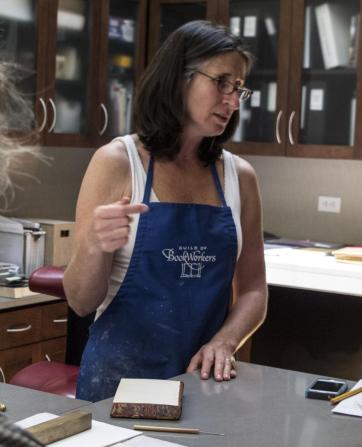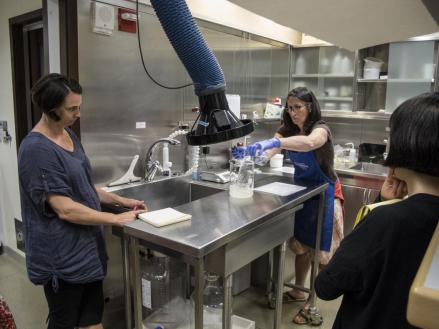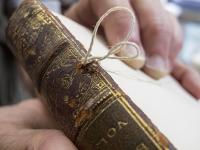Last summer, the Conservation Department had the opportunity to travel to Washington, D.C. for a workshop with Renate Mesmer at the Folger Shakespeare Library.




Renate Mesmer the Head Conservator of the Folger Shakespeare Library explaining and demonstrating various techniques.
While there, we learned several state-of-the-art techniques in conservation practice.
Among many, one of the eye-opening techniques we learned is called “Joint Tacketing or Board Tacketing”. It is a very simple and less-invasive method of reattaching detached or loose boards. This technique is ideal for mending books with intact text blocks and spines, but where the covers are detached or the hinge is broken. It works for both hollow-back and tight-back structures. As we have completed most of the deteriorated volumes that require a whole new binding, we have encountered several volumes that are perfect candidates for this fairly simple and efficient technique.
It is a big challenge for the conservators to decide the best way of treatment to balance these three priorities: least sacrifice of the original quality, function, and the efficiency of the execution.
Instead of slotting boards or lifting the leather on the boards all across the joint area, this technique requires only several small spots drilled and cut. Also, there is the minimal use of new materials which maximizes preserving the original appearance.
Below are some of the photos of Renate Mesmer’s demonstration on Joint Tacketing.






The linen threads and two small pieces of airplane cotton are the only materials used in this technique.
We have applied this board attachment method to the books in the Bank of North America collection. Below are images of our treatment procedure in HSP Conservation lab.



These books from BNA collection (above) had detached and loose covers while the text block and spine were still intact where the condition required a board attachment.

Using a hand-held push drill (Jeweler's drill), carefully drill a hole through the shoulder.

Lacing through beading wire as a needle to get thread through the hole.

Cutting a groove into the spine next to the hole to hide the thread.

Using a small piece of airplane cotton, create bridges for the head and tail of the spine.

The linen threads and airplane cotton are all attached to the spine.

The cover is ready to be reattached to the textblock.

Trimming the linen threads before tucking underneath the leather on the cover board.

Using Lascaux, which is reversible and flexible synthetic adhesive, to glue down the thread on the board under the leather.

The detail view from the outside of the book showing the thread knot holding the text block and board together.

The detail view from the inside of the cover showing the thread knot holding the text block and board together.

The inner hinge of trimmed Washi (Japanese paper) or Han-ji (Korean paper).

Pasted down Han-ji hinge over the board covers the gap and the tacketted spots along the joint.

The board attachment procedure is completed without any dramatic change of the original appearance.

After completing the board attachment, carefully touching up the white cotton bridges with acrylic paint for a better match to the original material.


Quick and simple touch made a big difference!
We have successfully reattached the boards with this new technique.
Although we cannot use this method of board attachment for treating every volume of the Bank of North America collection, it is a great method that responds to all of the three questions we have as conservators: functional longevity, retaining the original look, and the efficiency of the procedure.

